

Lesson Plan - Roles of Women: Story of An Hour. 1.
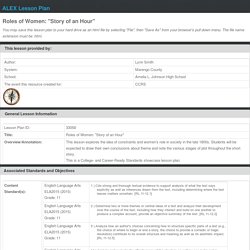
Teachers ask students in their groups to turn and talk and make a list of some of the things that can make them feel caged in or restricted. Discuss if any of the things they listed would be something they could break free from (job, relationship, etc.) 2. The above link or make copies for students to read for background information on women in the 1800s. Discuss the roles and limitations of women during this time. 3. 4. 5. 6. 7. 8.
Understanding Common Core State Standards. Books Used for My Library Lessons Weeks 10-18! - Elementary Library Mama. Books Used for My Library Lessons Weeks 10-18!
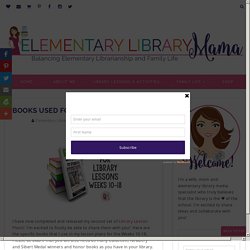
Elementary Library Mama 8:36 PM 1 comment I have now completed and released my second set of Library Lesson Plans! I'm excited to finally be able to share them with you! Here are the specific books that I use in my lesson plans for the Weeks 10-18. Please be aware that you will also need as many Caldecott, Newbery and Sibert Medal winners and honor books as you have in your library. Books used for my Library Lessons Weeks 1-9! - Elementary Library Mama. Books used for my Library Lessons Weeks 1-9!

Elementary Library Mama 3:24 PM No Comments I am so grateful for the positive feedback for my first set of Library Lesson Plans! When I created these lessons, I wanted to use books that were tried and true for me as an elementary librarian as well titles that would be found in most libraries. Here are the books that I refer to in my lesson plans for the first nine weeks. You should be able to find most of these in your library or at your local public library. YearatGlance. Scope & Sequence: Common Sense K-12 Digital Citizenship Curriculum. ElementarySchoolLibraryCurriculumMap. Information Literacy. TransitionWordsPhrasesCheatSheet. Exploring the Mystery Genre Unit Plan. Culminating Activity: Meet the Detectives Event To conclude the mystery unit, invite parents to come to school for a special "Meet the Detectives" event.
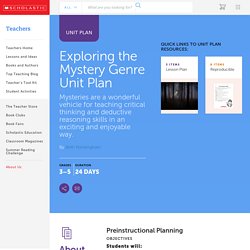
Students dress up as their favorite detective (or as a generic detective) and read the mystery they have written to their parents or other parents who visit. Poetry Writing Lessons for Kids - Kenn Nesbitt's Poetry4kids.com. There are many different ways to write poems as well as lots of techniques you can learn to help you improve your writing skill.
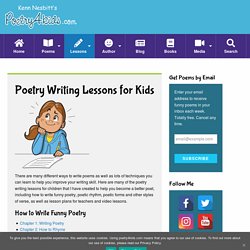
Here are many of the poetry writing lessons for children that I have created to help you become a better poet, including how to write funny poetry, poetic rhythm, poetic forms and other styles of verse, as well as lesson plans for teachers and video lessons. How to Write Funny Poetry Rhythm in Poetry. Batsatthelibraryeventkit. Where's Waldo? At the Library. Common Sense Media - Lesson Plans. Adas Violin CG. Each kindness. Keep kindness going primary lesson plan each kindness. Pandora's Box - Myths and Legends from E2BN. Story Starters: Creative Writing Prompts for Students. Ready to get students excited about writing?
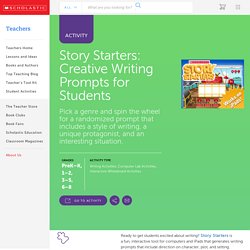
Story Starters is a fun, interactive tool for computers and iPads that generates writing prompts that include direction on character, plot, and setting. Your students will love watching the Story Starters' wheels spin. If they want to modify the prompt, they can simply pull the handle on the Story Starters Scrambler to change any piece of it! First, students choose one of four themes: Adventure, Fantasy, Sci-fi, or Scrambler.Then, students type their name and select their grade so they will get a grade-appropriate prompt.Next, they pull the lever to spin the wheels and generate a random writing assignment.Students choose a notebook, letter, newspaper, or postcard as their writing template.
They can opt to include a drawing, too, if they'd like.Once they’re finished writing in the activity, they can print or download their completed assignment. Get started. Learning Objectives. Harriet Tubman: A Lesson on Character and Bravery. Students should have basic knowledge of what slavery is and how the North and the South had extremely different views about slavery.
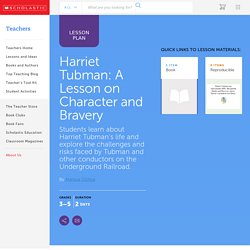
Day 1: Introduction to Harriet Tubman Step 1: Open a class discussion by talking about the purpose of a railroad and a conductor. Step 2: Ask students if they have any prior knowledge about the Underground Railroad. Use the computer and projector to share the Harriet Tubman Presentation with the class. Then give each table group or pair of students one of the copied sets of the Harriet Tubman Presentation slides. Step 3: Explain to students that they will be working together to place the events of Harriet Tubman's life in order. Step 4: Draw a time line on the board from Youth — to — Adult. The Journey to Civil Rights. Day 1 Step 1: Assess prior knowledge and ask students what we celebrate during the month of February (Black History Month).

Encourage students to think of various activities which are held throughout the school, city, and country. Why do we celebrate Black History Month? Explain to students that over the next few days, they will study an important era in black history that will help them better understand and appreciate historical events that helped shape our country's future. Step 2: Write the word "segregation" on the board. Harriet Tubman's Road to Freedom: Learning Activities About Slavery and Liberty. The lives of many African Americans throughout history are testament to strength, courage, and resourcefulness.

One of the best-known of these figures is Harriet Tubman, who persevered against great odds to improve not only her own life, but the lives of others. After a harrowing escape from slavery, she returned to the South 19 times and helped 300 other slaves escape. The story of her life, with its elements of drama, adventure, and success, provides a compelling focus of study during Black History Month, as part of your social studies curriculum, or in a language arts unit on biography. However you use it, your students are sure to be inspired by this heroic woman. Abraham Lincoln and Frederick Douglass: A Compare and Contrast Lesson Plan.
This lesson plan is suitable for Presidents’ Day, Black History Month, or during a study of abolition or the Civil War.
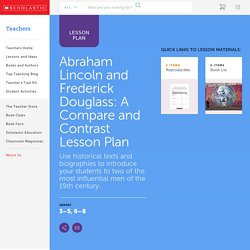
Students will: Research the lives of Abraham Lincoln and Frederick Douglass by reading historical texts and biographies.Identify and record key concepts about Abraham Lincoln and Frederick DouglassDevelop an understanding of Lincoln and Douglass by comparing and contrasting both their life experiences and their major accomplishments Introduction Abraham Lincoln and Frederick Douglass were born nine years apart, the former on a humble farm, the latter as a slave. Amelia and Eleanor Go For a Ride Lesson Plan. About the Book Amelia Earhart and Eleanor Roosevelt were both a lot alike. Both of them were outspoken, both were opinionated, and they both did what they believed in, no matter what people said. So it made perfect sense that the two women were friends. In April 1933, Eleanor was entertaining Amelia and her husband at the White House. Before dessert, the two women left to take a midnight plane ride over Washington, DC in Amelia Earhart's plane.
Before Reading the Book. Rosa Parks: How I Fought for Civil Rights. In 1955, city buses in Montgomery, Alabama, were segregated. Blacks had to sit in a separate section of the bus and give up their seat if a white person wanted it. One day, Rosa Parks refused to move because she was tired of being treated as a second-class citizen. “How I Fought for Civil Rights,” shares her story and how she inspired a generation to fight for civil rights. Plus, reading and writing activities help students understand the importance of every individual citizen in a democracy.
History of Jazz: A Black History in America Activity. As part of the Culture & Change: Black History in America online learning activity, students can learn about the History of Jazz (grades 3 and up), which was adapted from the Jazz for Young People Curriculum by Jazz at Lincoln Center. Each of the subjects covered includes text, audio, and links for students to read more: Students learn about the evolution of the blues, another African American-derived form of music. Famous trumpet player Wynton Marsalis explains how various types of music combined to become New Orleans jazz. Students meet Louis Armstrong, legendary jazz trumpet player, and learn how he shaped a new form of jazz called Improvisation.
Swing, a high-energy form of jazz beloved by the big bands of the 1930s, is described. While participating in The History of Jazz, students will study the history of jazz music to gain awareness of the cultural contributions made by different groups in America. 28 Days: A Black History Month Lesson Plan. Pre-read the book, including the author’s note.Gather credible websites and other books if you wish for the class to do further research.Make 28 copies of the 28 Days Graphic Organizer printable for each student. Or, prepare lined writing paper. The 28 individuals and events included in 28 Days are: Day 1 Crispus AttucksDay 2 Dred Scott decisionDay 3 Robert SmallsDay 4 14th AmendmentDay 5 Daniel Hale WilliamsDay 6 Plessy v. Let it Shine: Stories of Black Women Freedom Fighters Lesson Plan. Warm-up Activity Examine the illustration on the front cover.
What do you notice? In a brief journal response, describe what you see in the picture. Be specific and detailed in your writing. Meet Mae Jemison: A Challenging the Space Frontier Activity. With Scholastic’s “Meet Mae Jamison” activity, students have the unique opportunity to meet a super scientist! Great Stories for Women's History Month. Ruby Bridges: A Simple Act of Courage Lesson Plan for Kindergarten to Grade 2. The activities in this lesson plan coordinate with the "Ruby Bridges: A Simple Act of Courage" unit. Ruby Bridges: A Simple Act of Courage Common Core Lesson Plan for Grades 3–5. Suggested Sequence Each session is intended to take approximately 60 minutes.
Rad American Women A–Z Lesson Plan. This lesson introduces individuals who are not typically written about in history books, but deserve recognition for their achievements and impact. Malala: A Champion For Women’s Rights. Note: Malala’s life story includes violence, directed at her while she was a child. Make sure to consider your classroom community while discussing this story. Step 1: Tell the class that they are going to learn about a real girl named Malala Yousafzai. Preview the cover of the book with your students and ask if anyone has heard her story. Create a KWL chart about Malala. Fill out “What I Know” and “What I Want to know” with the class.
NEA. SBBB overview1. Grammar Worksheets: Articles (A, An, The) Black History Month - BrainPop. Biography Lesson Plan: Introduction to Biographies. Grade: 01 CCSS.ELA-Literacy.RI.1.9 Identify basic similarities in and differences between two texts on the same topic (e.g., in illustrations, descriptions, or procedures). Biography. Biography. Greek Gods Lesson Plans and Lesson Ideas. Biography Lesson Plans and Lesson Ideas. Primary and Secondary Sources. What Is a Myth? Introducing the Genre. Kindergarten Worksheets & Lessons. 1st grade Worksheets & Lessons.
2nd grade Worksheets & Lessons. 3rd grade Worksheets & Lessons. 4th grade Worksheets and Lessons. 5th grade Worksheets & Lessons. English Worksheets Land. Lesson Plans For Teachers. Black History Month. English Language Arts and Literacy, Social Studies. RosieRevere BG. Rosie Revere, Engineer by Andrea Beaty - Unleashing Readers. Rosie revere event kit v2. Lsp ll engineer mar15.
Information Skills Lesson Plans. Featured Book Teaching Guides. Teacher's Guide for The Polar Express by Chris Van Allsburg. A Day in First Grade.
Media Center Lessons - home. Library Lesson Bank and Guides. Grades 1 and 2 - Common Sense Education. Non-Fiction Text Features - 2nd grade. Explain Everything-How to use the OPAC. Librarylessonsforall - OPAC lesson plans. NYLearns.org - Learning to Use the Library OPAC by St. Lawrence-Lewis BOCES. Second Grade Library Lesson Plans.
First Grade Library Lessons. Informational Writing: Conclusions. Find Author’s Claim with Reasons and Evidence. Determining the Theme of a Poem. Argument Writing: Claim, Reasons & Evidence. Poetry: Figurative Language. Power Reading. Identifying Parts of a Book. Media Center / Fun Stuff (Library Games) Pre-School Activity Library. Library Learning Games - media center. National Poetry Month Ideas from Elementary Librarian on Pintrest. Monthly Themes: National Poetry Month. Lesson Plan: Henry’s Freedom Box (3rd Grade) Henryboxbrownmap. I CAN Statements for Library Skills (freebie) by Summer Pittman. Holidays & Special Days.
Poets.org - Materials for Teachers. Lesson Plans. Lesson Plans for Media Specialists. 5-Day Unit Plan for Introducing Nonfiction. 3rd Grade Library Curriculum. 4thGrade Library Curriculum. 6thGrade Library Curriculum. 5thGrade Library Curriculum. Lesson Plans and Educator Resources - The United States Mint.